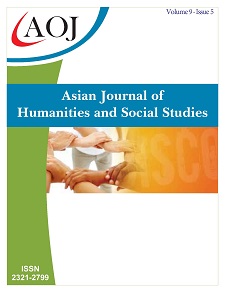An Online Participatory Observation: The Online Depression Community's Discussion on Depression Treatment
DOI:
https://doi.org/10.24203/ajhss.v9i5.6797Keywords:
health communication, depression, science communication, depression community, online participation observationAbstract
This article uses the online participatory observation method to analyze more than 2,000 posts of the "Sunshine Project Psychological Mutual Assistance Forum" in Mainland China. The research observed the discussion of depression in the online patient community in anonymous forums, including the popularization of medical knowledge about diseases, self-disclosure of patient diagnosis and treatment experience, patient interaction, and patient discussions on controversial issues and rumors of the disease. The results of the study show that the online community of depression patients is both a "web of information" and a "web of mutual help." The patient's health information acquisition mode has changed from vertical reception to horizontal interconnection, which not only enhances patients' scientific understanding of the disease but also allows them to increase their sense of psychological security in their interpersonal interactions. In this new type of risk communication mode, how to establish a new fact-checking mechanism and establish ordinary people's trust in scientific and medical knowledge is a new challenge.
References
Abrams, R. (2002). Electroconvulsive therapy. Oxford University Press.
American Psychiatric Association (2013).Diagnostic and statistical manual of mental disorders, 5th edition: DSM-5. Washington, DC: Author.
Chen Caihui, Xia Yixin, Zhou Guiru (2004). Clinical Analysis of Cognitive Behavior Group Therapy in Patients with Depression . Tzu Chi Journal of Nursing , 3(1), 19-27.
Chen Junqin (2004). Depression and Depression . Taipei: Healthy.
Dong Wei (2010). Research on Depression Reporting from the Perspective of Health Communication . News World , (5), 91-93.
Freud (2018). Introduction to Psychoanalysis (New Edition) (Vol. 281). Left bank.
Jiang Yang (2018). Research on the Communication of Depression Issues from the Perspective of Health Communication , Master's thesis. Chongqing: Chongqing University.
Klin, A. & Lemish, D. (2008). Mental disorders stigma in the media: Review of studies on production, content, and influences. Journal of Health Communication, 13(5), 434−449.
Lin Meiyang (2001), Study on the Impact of Cognitive Behavioral Therapy Group on Patients with Depression and the Treatment Effect , unpublished doctoral dissertation. Changhua: National Changhua Normal University.
Liu Yi'an (2017). Is Electrotherapy Scary to Treat Depression?
Morris, G. (2006). Mental health issues and the media- An introduction for health professionals. New York: Routledge.
Nairn, R. G.. (2007). Media portrayals of mental illness, or is it madness? A review. Australian Psychologist, 42(2), 138−146.
Pang Xu (2016). Research on Depression Reporting from the Perspective of Health Communication (2011-2015) . Master thesis of Journalism of East China Normal University.
Philo, G.. (Ed.) (1996). Media and mental distress. London and New York: Longman.
Ren Jinzhou, Kang Yunkai (2015). Depression from the Perspective of Health Communication in my country's Television Media, Media Today, 23(11), 165-167.
Shu Manqiao, Xu Weilong, Anbang, Zhao Fangxia, Zhang Juan (2014). The Effect of Psychotherapy on the Rehabilitation of Depressed Patients. Occupational Health and Injuries , 29(2), 162-163.
Stansbury,K., &Gunnar, M. R. (1994). Adrenocortical activity and emotion regulation. Monographs of the Society for Research in Child Development, 59(2-3), 108-134.
Wahl, F. O., & Roth, R. (1982). Television images of mental illness: Results of a metropolitan Washington media watch. Journal of Broadcasting, 26(2), 599−605.
Wahl, F. O., Wood, A., & Richards, R. (2002). Newspaper coverage of mental illness: Is it changing? Psychiatric Rehabilitation Skills, 6(1), 9−31.
Wu Mengjin, Xu Meiling (2011). The Biomedical Reality, Social Cultural Reality and News Reappearance of Depression: Taking Taiwan's China Times and Apple Daily as examples, Journal of Communication and Sociology, (17), 87-121.
Ye Suijun (2010). Eight weeks of exercise intervention on the physical activity, physical fitness and quality of life of the visually impaired . Dissertation of Pingtung University of Science and Technology Department of Leisure Sports and Health Care.
Downloads
Published
Issue
Section
License
Copyright (c) 2021 Hsinzhu Wu

This work is licensed under a Creative Commons Attribution-NonCommercial 4.0 International License.
- Papers must be submitted on the understanding that they have not been published elsewhere (except in the form of an abstract or as part of a published lecture, review, or thesis) and are not currently under consideration by another journal published by any other publisher.
- It is also the authors responsibility to ensure that the articles emanating from a particular source are submitted with the necessary approval.
- The authors warrant that the paper is original and that he/she is the author of the paper, except for material that is clearly identified as to its original source, with permission notices from the copyright owners where required.
- The authors ensure that all the references carefully and they are accurate in the text as well as in the list of references (and vice versa).
- Authors retain copyright and grant the journal right of first publication with the work simultaneously licensed under a Attribution-NonCommercial 4.0 International that allows others to share the work with an acknowledgement of the work's authorship and initial publication in this journal.
- Authors are able to enter into separate, additional contractual arrangements for the non-exclusive distribution of the journal's published version of the work (e.g., post it to an institutional repository or publish it in a book), with an acknowledgement of its initial publication in this journal.
- Authors are permitted and encouraged to post their work online (e.g., in institutional repositories or on their website) prior to and during the submission process, as it can lead to productive exchanges, as well as earlier and greater citation of published work (See The Effect of Open Access).
- The journal/publisher is not responsible for subsequent uses of the work. It is the author's responsibility to bring an infringement action if so desired by the author.


